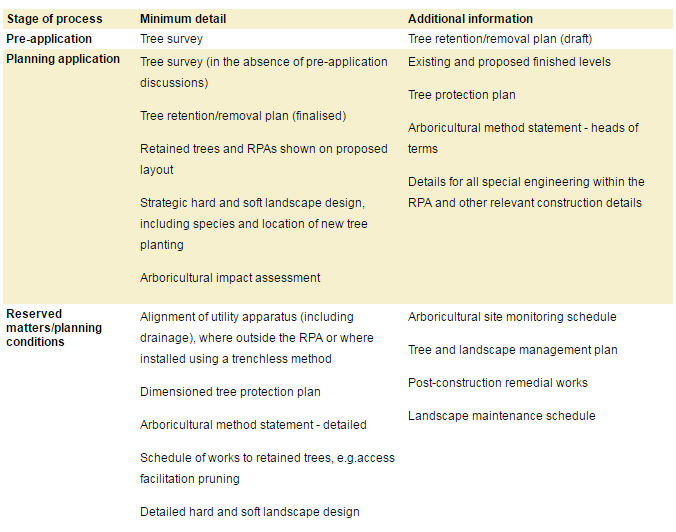BS 5837 Tree survey
Under the UK planning system, Local Planning Authorities have a statutory duty to consider the protection and planting of trees when granting planning permission for proposed development. The potential effect of development on trees, whether statutorily protected (e.g. by a Tree Preservation Order or by their inclusion within a conservation area) or not, is a material consideration that is taken into account in dealing with planning applications. In addition, where trees are statutorily protected, it is important to contact the Local Planning Authority and follow the appropriate procedures before undertaking any works that might affect the protected trees.
The nature and level of detail of information required to enable a local planning authority to properly consider the implications and effects of development proposals varies between stages and in relation to what is proposed. Table B.l provides advice to both developers and local authorities on an appropriate amount of information. The term "minimum detail" is intended to reflect information that local authorities are expected to seek, whilst the term" additional information" identifies further details that might reasonably be sought, especially where any construction is proposed within the RPA.
Any loss of, or the negative effect on trees, is a material planning consideration which the Local Planning Authority (LPA) will take into account when a planning application is determined. Because trees can offer many benefits, including providing visual amenity, softening or complementing the effect of the built environment, adding maturity to new developments, displaying seasonal change and providing opportunities for wildlife in built-up areas, the council will want developers to retain existing healthy trees with an estimated lifespan of over 40 years within the design of a proposed future development.
When trees have been agreed or required to be retained they become an important factor on construction sites especially when on or near the working areas. British Standard 5837 is intended to assist with decision-making with regard to existing and proposed trees in the context of design, demolition and construction. Tree consultants are required to assess the both the development site and the proposals for conflicts with tree root systems, tree stems and canopies, including allowance for both future movement and growth commonly known as “post development tree resentment”.
The space required for existing and proposed new trees to be retained and to become established is an important consideration in both the design and the planning process. During their lifetime, trees will be vulnerable to disturbance, compaction, pruning, environmental changes, pests and diseases. Construction work often exerts pressures on existing trees, as do changes in their immediate environment following the construction.
Where tree retention or planting is proposed in conjunction with nearby construction, the objective will be to achieve a harmonious relationship between trees to be retained and proposed structures that can be sustained in the long term. The good practice recommended in BS5837 is intended to assist in achieving this objective. The standard follows a logical sequence of events that ultimately has tree protection as its main aim.
Every planning application is different and the amount of information required to support a proposal will vary in each case. For example a planning application for a conservatory might not require the level of detail that is needed to accompany a planning application for the development of a site with one or more dwellings. We look at every application on its own merits and can quote to provide tree surveys for use in planning applications to both Cheshire East and Chester West & Chester borough councils.
Table B.1. Delivery of tree-related information into the planning system


